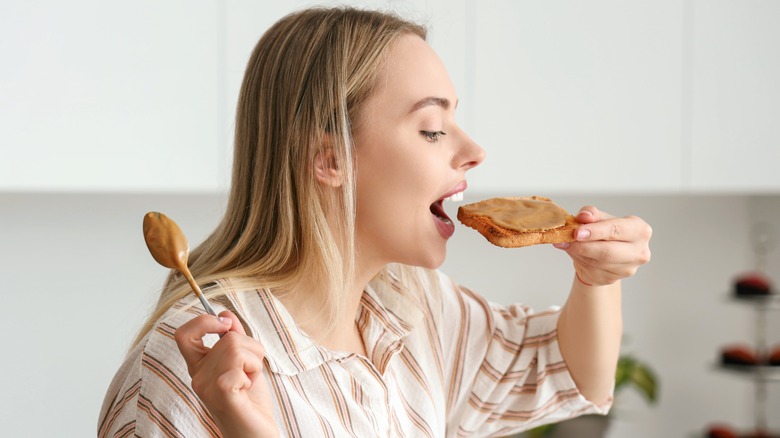Everything That's Not Healthy About Low-Fat Peanut Butter
Most foods touted as "healthy" are quite obvious. You're aware of the many benefits of fruits and vegetables, for example. Nothing beats the nutritional value, and there are many reasons to incorporate them into your diet. Beyond these usual suspects, though, low-fat peanut butter is also considered a typically healthy snack option.
It makes sense. It's an easy choice to grab when you want something quick and filling. It pairs well with everything from celery sticks and apples to crackers and toast. The myriad options are endless. There's also the fact that it's lower in fat than conventional peanut butter. That automatically makes it a "health food" — right?
Not so fast! Although it's true that they may trim the fat from your diet, this type of peanut butter may not be exactly what you need if you're hoping to get healthier. Although it defies common conceptions, this low-fat food could actually be worse for you than you could have imagined. Manufacturers have to do something to the food to make up for the lack of fat, after all, and that's where the questionable ingredients come into play. Here's what you may not want to be so quick to jump on the low-fat peanut butter bandwagon.
Low-fat peanut butter contains added sugars
Where does low-fat peanut butter get its relatively pleasant flavor? Well, you can actually blame the lack of fat for the infusion of sweetness. That's because manufacturers often replace the fat that would otherwise be incorporated in their recipes with an unwelcome substitute to boost flavor: sugar. These may be derived from a variety of sources, like plain sugar, molasses, or corn syrup solids.
In other words, what you once thought was a seemingly healthy condiment is actually something that happens to add a heap of unwanted extra sugar to your day, which is typical for many products labeled fat-free or low-fat. "These are unnecessary and add extra, unwanted fat and calories," says Natalie Rizzo, a registered dietitian and a nutrition editor for TODAY.com. And according to Rizzo, it's those peanut butters with the added sweetness that are among the very worst available.
It's important to read the ingredient label to be entirely sure of what's in your low-fat peanut butter. Honey and agave are other additives that may not seem unhealthy, per se, but definitely change the nutritional profile of your purportedly "healthy" low-fat peanut butter. It's crucial to manage your intake for your future health, explains Dr. Frank Wu, who's a nutrition professor at the Harvard T.H. Chan School of Public Health. "Basically, the higher the intake of added sugar, the higher the risk for heart disease."
Oils are sometimes added to improve the texture of low-fat peanut butter
If you assumed that removing most or all of the fat from peanut butter would change its consistency, you aren't mistaken. It's the fat that lends peanut butter its inherently rich texture and lubrication. Removing the fat might seem like a smart move, but it robs the food of what makes it so appealing in the first place.
Manufacturers have to do something to fill this gap and make sure that their products still appeal. Stripping peanut butter of its fat usually means incorporating oil to improve mouthfeel and maintain the texture consumers expect. Known as "fat replacers," oils can be processed and hydrogenated. While they may prevent peanut butter from becoming dry, crumbly, separated, and generally unpleasant to eat, they also dramatically reduce the nutritional value of the food by increasing the food's trans fat content.
This, naturally, is problematic because the added trans fats can increase your risk of developing heart disease and high cholesterol. It's important to check the ingredient label to ensure that the "healthy" peanut butter you're considering isn't just masquerading as something it's not. Keep in mind that even if a product contains 0.5 grams of trans fats or less, the manufacturer can claim that it contains "0 grams" per U.S. Food and Drug Administration (FDA) guidance. If the label says it contains hydrogenated oil, you can confirm that it contains at least some trans fat –and therefore should be avoided.
Low-fat peanut butter could have excess sodium
It's not just oil and sugar that take low-fat peanut butter in the wrong direction. To make up for the lack of fat, peanut butter manufacturers may also add sodium to their recipes. This may give the substance a little flavor boost. While sodium isn't inherently always bad for everyone, it's very important for people who have hypertension or anyone who is at risk of developing high blood pressure to avoid excess sodium intake.
Given that the American Heart Association (AHA) recommends that the average adult consume no more than 2,300 milligrams of sodium per day, it can be easy to go overboard, especially if you aren't accustomed to checking the labels. That's especially true of peanut butter, which people may not even suspect could be a sodium-rich culprit. But, says Shena Jaramillo MS, RD, to Eat This, Not That!, it can play a fairly pivotal role in your overall health if you eat it regularly. "Many mainstream brands of peanut butters are loaded with added sugars, salt, and hydrogenated oils. This can potentially lead to hypertension if consumed in excess."
To be safe, always check the label of your preferred peanut butter — and be especially careful if it's low-fat, as the manufacturer may have added extra salt for some added flavor. There are peanut butters available that contain no sodium at all. If you're told to monitor your sodium, it's better to opt for "regular" peanut butter and consume it in moderation.
Low-fat peanut butter isn't as nutrient-rich
Stripped of their natural fats, reduced-fat peanut butters may actually not be the picture of health that you imagine them to be. In fact, the food loses a great deal of its nutritional value as a result. That's because, in its "normal" state, peanut butter is actually considered a very heart-healthy food. In fact, there's plenty of evidence to support the benefits of eating nuts on a regular basis. According to Dr. Meir Stampfer, a professor of nutrition and epidemiology at the Harvard T.H. Chan School of Public Health, "Botanically, peanuts are not nuts, but nutritionally they are very similar to tree nuts, and other studies have shown their benefits." He adds, "Even if you don't like nuts, it would still be a good idea to eat a handful every day."
What better way than to eat a little bit of peanut butter every day? Frances Largeman-Roth, a registered dietitian, told The Daily Meal, "The majority of the fat that peanuts (and peanut butter) contain is heart-healthy monounsaturated fat." In other words, what you see on a label of traditional, full-fat peanut butter may not be so bad after all when it's consumed in moderation.
You could otherwise be missing out on many of the vital benefits that nuts introduce to your diet. The healthy fats in peanut butter could benefit your heart and promote healthy cholesterol levels while protecting you from developing issues in the future like cardiovascular disease and stroke.
Lack of unsaturated fat reduces peanut butter's other benefits
It's not just your cardiovascular health that benefits from the unsaturated fats in regular peanut butter. Without that fat, eating peanut butter is far less beneficial to the body overall. In fact, research has found that peanuts are a "brain food" that can support cognitive health. One study published in The Journal of Prevention of Alzheimer's Disease revealed that adults between the ages of 60 and 80 who didn't consume peanuts or peanut butter on a regular basis were up to 50% more likely to perform poorly on cognitive testing. Everything from learning to memory to attention span could be affected.
The healthy fats and polyphenols in peanut butter could also be beneficial to younger individuals. In a study of people between the ages of 18 and 33, for example, it was revealed that eating peanut butter (or peanuts) could boost memory and even reduce symptoms of stress, anxiety, and depression (via Clinical Nutrition).
It's true that just because a peanut butter variety is low in fat doesn't mean that it automatically contains fewer other valuable nutrients, like niacin (which supports cognitive health) and resveratrol (which is considered a brain- and heart-booster). However, you'll generally reap a much broader and fuller scope of overall health benefits by eating full-fat peanut butter in moderation instead.
Low-fat peanut butter may not taste as good
If you're used to eating regular peanut butter, you could be in for a bit of a rude awakening when you make the switch to a low-fat recipe. There's a definite adjustment involved, as the added ingredients could make it taste significantly different to you. That's typically due to the inclusion of fillers and extra sweeteners, both of which can change the texture and taste — and potentially making it less pleasant for you to consume. While you might keep eating it due to its so-called "healthy" nutritional profile, the truth is that your choice may backfire because you're missing out on eating the actual healthy form of peanut butter with its full fat content.
It's one of the rare fatty foods that you can actually feel good about consuming on a regular basis — albeit with a caveat, warns Dana Purcell, RD, who is a registered dietitian at the Hartford HealthCare Digestive Health Institute. "It does have higher calorie and fat content, though, and while the majority is unsaturated fat, portion sizes and moderation are important."
Snacks should satisfy you in different ways. Yes, they should keep you full between meals and prevent you from overeating — but they should also taste good to keep you motivated to eat them. Full-fat peanut butter is healthy and versatile, but if it tastes different, you may be less compelled to keep eating it. It's worth making the right choice for that reason alone.
Eating low-fat peanut butter could be less satisfying
Because the healthy fat in regular peanut butter promotes a sense of fullness, it's better for managing appetite and preventing overeating. But without that fat, a low-fat version might make you feel less satisfied and lead to overeating. This could backfire if you have a specific health goal tied to your desire to eat low-fat, be it weight loss or simply snacking less. It's perfectly fine to snack on full-fat peanut butter as a part of a healthy, well-rounded diet — and as a snack, it can be especially beneficial.
Registered dietitian Karen Hemmes of the Banner – University Medical Center Phoenix says that going the low-fat route can actually derail your efforts. "Some low-fat foods are high in sugar, sodium and starch and may actually counter any health goals you are hoping to make," she confirms. "Frequently eating highly processed, low-fat foods may increase your risk of metabolic disorders. Your body needs dietary fat to absorb vitamins A, D, E and K. By limiting fat, your body may not get necessary nutrients it needs."
All of this can contribute to a food that's decidedly less satisfying on the whole — and that may lead you to reach for it more frequently than you otherwise would in an effort to satisfy your appetite. If you're focused on health, aiming for a moderate serving of regular peanut butter daily is a practical way to incorporate it into your diet (and feel good about your choice).







